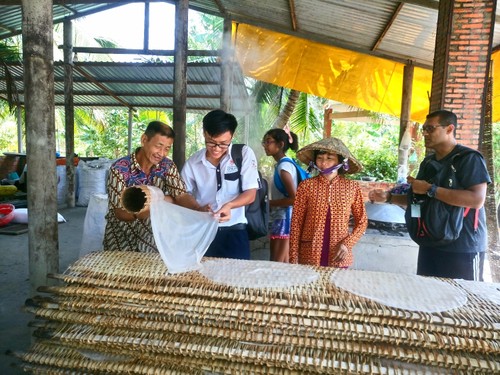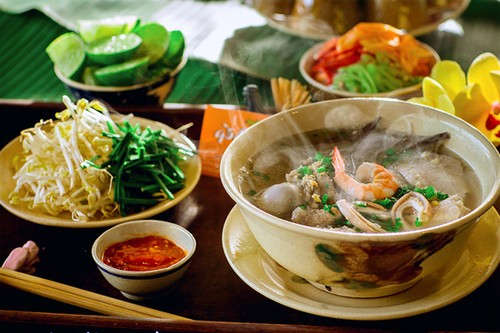A: Welcome to VOV24/7’s Food Delight.
B: Normally, on the show, we have chefs who share with us their special recipes as well as cooking tips. But today, we will take you on a trip to a family-run Hu Tieu noodle factory to see how the noodles are made.
A: The “Homeland” noodle factory stands near the Cai Rang floating market in Can Tho city. Visitors can observe the whole process of turning flour into noodles, and even try their hand at the production process.
B: We’re standing inside the factory, where workers are preparing to make a batch of hu tieu noodles.
“We use rice husks or longan shells to fuel the fire. To make the noodles, rice flour is mixed with tapioca starch in a ratio of 4:1 to make chewier noodles. Water is added to make a loose batter which is then spread evenly over the surface of a steamer and covered for 30 seconds to steam. The cooked noodle sheets are then laid out on bamboo racks to dry in the sun. We have 4 types of noodles dyed with natural leaves including pandan, leaves of magenta plant, beetroot, and baby jackfruit.” a worker said.
 A family-run Hu Tieu noodle factory in Can Tho (Photo: thamhiemmekong.com) A family-run Hu Tieu noodle factory in Can Tho (Photo: thamhiemmekong.com) |
A: Once the sheets are almost dry, they’re machine-cut into noodles and arranged in bunches ready for packaging.
B: Customers can buy the dried noodles and make bowls of noodle soup with chicken, beef, or crab toppings for their family.
A: The workers at the factory were pleasant, welcoming, and willing to answer our many questions. They said the noodles are often made into deep fried noodle cakes with shredded pork on top.
“The dried noodles are washed with boiling water, then cold water before being marinated with salt and seasoning powder for 24 hours. The noodles are pressed into a round patty shape and submerged in boiling oil in a pan, flipped to brown both sides and sprinkled with chopped green onion and sawleaf. Each cake bears an expiration date of 30 days after its date of manufacture. The cake is served best with chili paste.”
 A bowl of Hu Tieu noodle soup (Photo: hoidaubepaau.com) A bowl of Hu Tieu noodle soup (Photo: hoidaubepaau.com) |
A: A more surprising product is “Pizza Hu Tieu”. There is no dough, no pastry base. Vietnamese Rice Noodle Pizza is made of deep fried noodles, covered by peanuts, pork, and herbs.
B: I was a bit skeptical at first. Noodle pizza didn’t sound very tasty, but I have to tell you, it was one of the best things I ate in Can Tho.
“The pizza is deep fried noodle cake with toppings that include coconut cream, roasted peanuts, roasted pork, and milk. A noodle pizza should be served right after it’s made, as it will not be as crunchy after 1 or 2 hours. This means if you want to try this pizza, you should order it here. However, you can make a homemade version by preparing the toppings and spreading them on a pre-packaged noodle cake. The toppings can include seafood, chicken, or pork.
A: Noodle pizza is sometimes served with spicy tomato sauce or soy sauce. If you’re planning a trip to the Mekong Delta, don’t miss a chance to visit the noodle factory and treat yourself to a big bowl of Hu Tieu or a giant Hu Tieu Pizza.
B: If you liked today’s show, please let us know by visiting our Facebook Fanpage, VOV5 English Service, and leaving a comment. And tell us what you’d like us to cook next time. Good luck and see you next time.